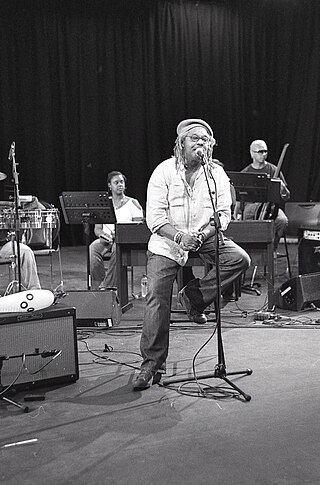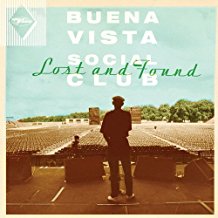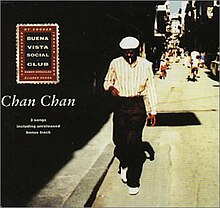
Máximo Francisco Repilado Muñoz Telles, known professionally as "Compay Segundo", was a Cuban trova guitarist, singer and composer.

Buena Vista Social Club is a 1999 documentary film directed by Wim Wenders about the music of Cuba. It is named for a danzón that became the title piece of the album Buena Vista Social Club. The film is an international co-production of Germany, the United States, the United Kingdom, France, and Cuba.

Rubén González Fontanills was a Cuban pianist. Together with Lilí Martínez and Peruchín he is said to have "forged the style of modern Cuban piano playing in the 1940s".

Buena Vista Social Club was a musical ensemble primarily made up of Cuban musicians, formed in 1996. The project was organized by World Circuit executive Nick Gold, produced by American guitarist Ry Cooder and directed by Juan de Marcos González. They named the group after the homonymous members' club in the Buenavista quarter of Havana, a popular music venue in the 1940s. To showcase the popular styles of the time, such as son, bolero and danzón, they recruited a dozen veteran musicians, some of whom had been retired for many years.

Afro-Cuban All Stars is a Cuban band led by Juan de Marcos González. Their music is a mix of all the styles of Cuban music, including bolero, chachachá, salsa, son montuno, timba, guajira, danzón, rumba and abakua.

Ibrahim Ferrer was a Cuban singer who played with the group Los Bocucos for nearly forty years. He also performed with Conjunto Sorpresa, Chepín y su Orquesta Oriental, and Mario Patterson. After his retirement in 1991, he was brought back in the studio to record with the Afro-Cuban All Stars and Buena Vista Social Club, in March 1996. He then toured internationally with these revival groups and recorded several solo albums for World Circuit, before his death in 2005.

Buena Vista Social Club is a studio album by Buena Vista Social Club, an ensemble of Cuban musicians directed by Juan de Marcos González and American guitarist Ry Cooder. Produced by Cooder, it was recorded at Havana's EGREM studios in March 1996 and released on September 16, 1997, through World Circuit internationally and Nonesuch Records in the United States. It is the only standard studio album exclusively credited to the Buena Vista Social Club.

Omara Portuondo Peláez is a Cuban singer and dancer. A founding member of the popular vocal group Cuarteto d'Aida, Portuondo has collaborated with many important Cuban musicians during her long career, including Julio Gutiérrez, Juanito Márquez and Chucho Valdés. Although primarily known for her rendition of boleros, she has recorded in a wide range of styles from jazz to son cubano. Since 1996, she has been part of the Buena Vista Social Club project, touring extensively and recording several albums with the ensemble. She won a Latin Grammy Award for Best Contemporary Tropical Album in 2009, a Latin Grammy Award for Best Traditional Tropical Album in 2023, a Latin Grammy Lifetime Achievement Award in 2019, and she received three Grammy Award nominations in 2019 and a nomination in 2024.

Eliades Ochoa Bustamante is a Cuban guitarist and singer from Loma de la Avispa, Songo La Maya in the east of the country near Santiago de Cuba.
La Vieja Trova Santiaguera is a Cuban musical band that formed in 1994 and became successful in Europe. Its members included:
Manuel "Puntillita" Licea was a Cuban popular singer. Puntillita was active in the 1940s and 1950s, and later gained notice when he joined other elderly Cuban musicians to form the Afro-Cuban All Stars and the associated group of singers who recorded the Buena Vista Social Club with American guitarist Ry Cooder.

Benito Antonio Fernández Ortiz, better known as Ñico Saquito, was a Cuban trova songwriter, guitarist and singer. He is widely considered the most prolific and successful composer of guarachas, most of which he wrote during his stint as a member of Los Guaracheros de Oriente. Among his most enduring compositions are "Cuidadito compay gallo", "María Cristina", "Adiós compay gato", "Al vaivén de mi carreta", "Camina como Chencha" and "Amarrao compé".

Trova is a style of Cuban popular music originating in the 19th century. Trova was created by itinerant musicians known as trovadores who travelled around Cuba's Oriente province, especially Santiago de Cuba, and earned their living by singing and playing the guitar. According to nueva trova musician Noel Nicola, Cuban trovadors sang original songs or songs written by contemporaries, accompanied themselves on guitar, and aimed to feature music that had a poetic sensibility. This definition fits best the singers of boleros, and less well the Afrocubans singing funky sones or even guaguancós and abakuá. It rules out, perhaps unfairly, singers who accompanied themselves on the piano.

Buena Fe is a pop music band from Cuba, formed in 1999 in the province of Guantánamo, initially composed only of Israel Rojas Fiel and Yoel Martínez Rodríguez. They have released ten studio albums: Déjame entrar (2001), Arsenal (2003), Corazonero (2004), Presagios (2006), Catalejo (2008), Pi (3,14) (2010), Dial (2013), Soy (2015), Sobreviviente (2017) and Carnal (2019).
Reinaldo Hierrezuelo La O, known professionally as Rey Caney, was a Cuban singer, guitarist, and tresero. Born in Santiago de Cuba as the youngest of 11 siblings, he led Cuarteto Patría for some time; this famous group is now led by Eliades Ochoa. In the middle 1950s, he took over Compay Segundo's place in the duo Los Compadres, as "Duo Los Compadres" they recorded for several record labels including Panart and Seeco, with the latter he also recorded as Rey Caney in New York City in 1960. The other partner being his elder brother Lorenzo Hierrezuelo. He and his brother sang together for thirty years. He also sang and played with many other groups, and finally came back to Santiago de Cuba to lead the Vieja Trova Santiaguera, one of the top groups in Cuba's second city. He also worked with his sister Caridad Hierrezuelo, a singer of guaracha style.
Cuarteto Patria is a musical group from Santiago de Cuba. It was founded in 1939 by Francisco Cobas la O, who was the director, along with Emilia Gracia, Rigoberto Hechaverría (Maduro), and Rey Caney. The group's original style was traditional trova, which included boleros and some música campesina. Over time, both the members and the music evolved, and Eliades Ochoa also became a member of the group.

Grupo Compay Segundo is a Cuban musical group created after the death of Compay Segundo by the remaining members of his band and his son, Basilio Repilado.

Buena Vista Social Club at Carnegie Hall is a live album by Buena Vista Social Club. The double album documents the band's complete performance at Carnegie Hall, New York City, on July 1, 1998. The album was produced by guitarist Ry Cooder and released ten years after its recording, on October 13, 2008, through World Circuit.

Lost and Found is a compilation album, and the third under the Buena Vista Social Club name, released on March 25, 2015 on World Circuit Records and Nonesuch Records. It is a mixture of leftover tracks from the Egrem studio sessions, and from a string of dates through the late 1990s and early 2000s, and live performances from the band in the years that followed.
Enrique Raúl Planas Fernández was a popular Cuban singer and songwriter. He performed and recorded with many bands and musicians, including Carlos Barbería y su Orquesta Kubavana, Sonora Matancera, Celia Cruz, Conjunto Rumbavana, Conjunto Chappottín, Charanga Rubalcaba, Rubén González, and the Afro-Cuban All Stars.
















